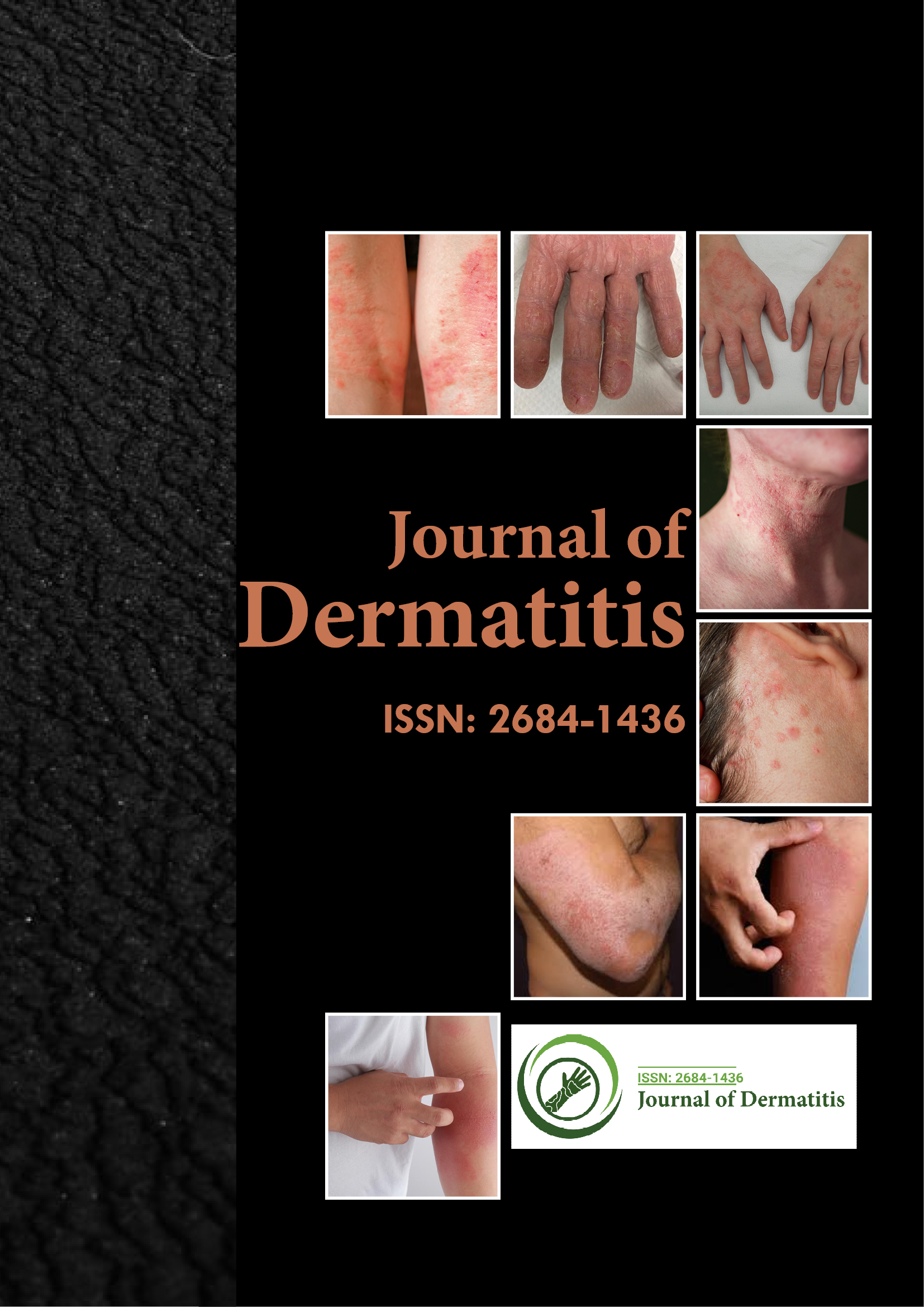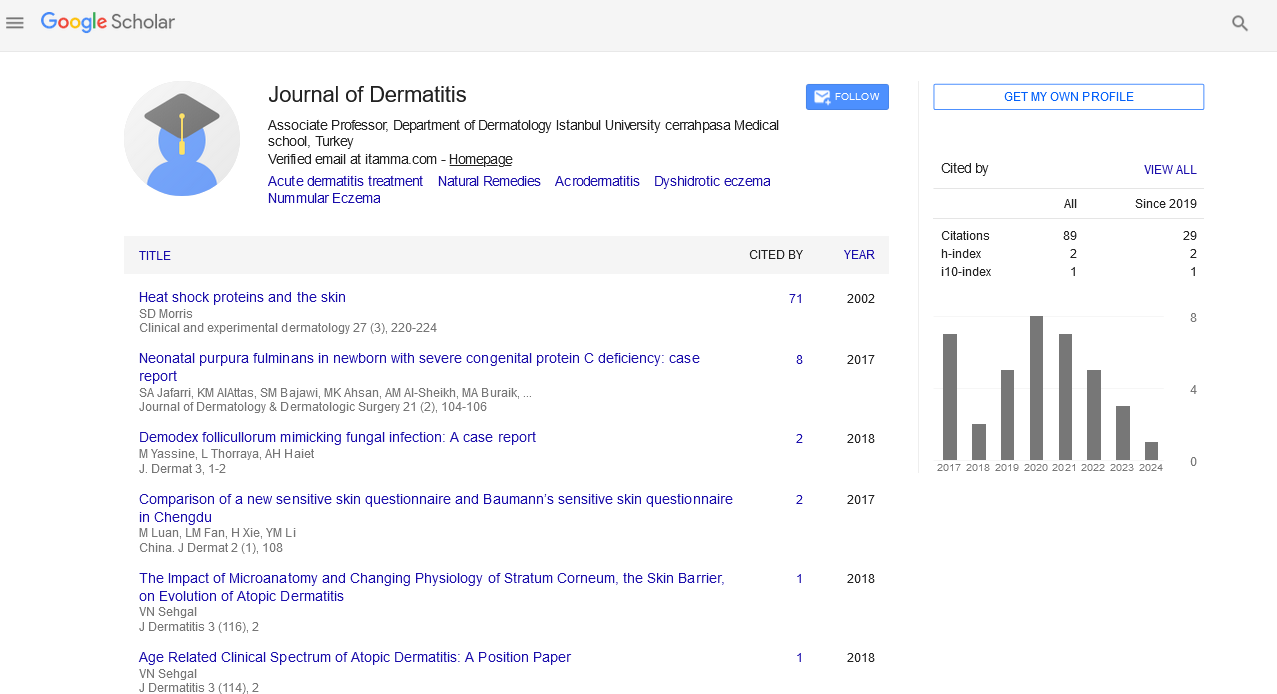Indexed In
- RefSeek
- Hamdard University
- EBSCO A-Z
- Euro Pub
- Google Scholar
Useful Links
Share This Page
Journal Flyer

Open Access Journals
- Agri and Aquaculture
- Biochemistry
- Bioinformatics & Systems Biology
- Business & Management
- Chemistry
- Clinical Sciences
- Engineering
- Food & Nutrition
- General Science
- Genetics & Molecular Biology
- Immunology & Microbiology
- Medical Sciences
- Neuroscience & Psychology
- Nursing & Health Care
- Pharmaceutical Sciences
Commentary - (2023) Volume 8, Issue 6
Mechanisms of Skin Barrier Inefficiency in Eczema: Implications for Therapeutic Strategies
Lynda Whitoh*Received: 17-Oct-2023, Manuscript No. JOD-23-23947; Editor assigned: 20-Oct-2023, Pre QC No. JOD-23-23947 (PQ); Reviewed: 03-Nov-2023, QC No. JOD-23-23947; Revised: 10-Nov-2023, Manuscript No. JOD-23-23947 (R); Published: 17-Nov-2023, DOI: 10.35248/2684-1436.23.8.225
Description
Eczema, also known as atopic dermatitis, is a common and chronic skin condition that affects millions of individuals worldwide. It is characterized by inflamed, itchy skin and a compromised skin barrier. Understanding the mechanisms underlying this skin barrier inefficiency is vital for developing effective therapeutic strategies to manage and treat eczema. This article delves into the intricate world of eczema and its implications for innovative treatments.
The skin serves as the body's first line of defense against external aggressors, including bacteria, viruses, allergens, and pollutants. A fully functional skin barrier is essential to maintain moisture, prevent irritants from penetrating, and regulate the immune response. In individuals with eczema, this barrier is disrupted, making the skin more susceptible to inflammation and irritation. The exact mechanisms that lead to this inefficiency are multifaceted.
Genetics plays a significant role in eczema. Several genes have been associated with the condition, many of which are linked to the production of proteins that contribute to skin barrier function. Mutations or variations in these genes can result in a weakened skin barrier, making individuals more prone to eczema. Understanding the genetic basis of eczema allows for targeted therapies that address the root causes.
One of the primary mechanisms of skin barrier inefficiency in eczema is a deficiency in filaggrin, a structural protein found in the outermost layer of the skin, the stratum corneum. Filaggrin is essential for maintaining proper hydration and acting as a protective shield. In individuals with eczema, a deficiency in filaggrin can lead to excessive moisture loss and increased susceptibility to external irritants. Therapeutic strategies may involve developing products that can replenish filaggrin or enhance its function.
Inflammation also plays a pivotal role in eczema. The skin of individuals with eczema is often characterized by elevated levels of pro-inflammatory cytokines. These molecules trigger an immune response, leading to redness, swelling, and itching. Chronic inflammation further weakens the skin barrier, creating a vicious cycle. Treatments may involve anti-inflammatory medications, topical corticosteroids, or newer biologic agents that target specific immune pathways.
Dysregulation of the skin microbiome is another mechanism contributing to eczema's skin barrier inefficiency. The balance of bacteria on the skin's surface is disrupted in individuals with eczema, with an overabundance of Staphylococcus aureus being a common finding. This overgrowth can exacerbate inflammation and skin barrier dysfunction. Therapies focusing on restoring a healthy skin microbiome, such as probiotics or topical microbiome-based products, hold for treating eczema.
Environmental factors can also trigger and exacerbate eczema symptoms. Allergens, irritants, and pollutants can penetrate the compromised skin barrier, leading to flare-ups. Identifying and minimizing exposure to these factors is a vital aspect of eczema management. Barrier creams and emollients can provide an additional layer of protection, helping to reduce the impact of environmental triggers.
In recent years, advances in biotechnology and personalized medicine have paved the way for more targeted and effective therapies for eczema. Precision medicine approaches aim to tailor treatments to an individual's specific genetic and immune profile. This allows for a more personalized and effective treatment plan that can address the unique mechanisms of skin barrier inefficiency in each patient.
In conclusion, understanding the mechanisms of skin barrier inefficiency in eczema is vital for the development of innovative therapeutic strategies. By unraveling the genetic, molecular, and environmental factors contributing to this condition, researchers and healthcare providers can offer more effective and personalized treatments for individuals living with eczema. The future of eczema management holds, as it continues to bridge the gap between science and patient care, ultimately improving the quality of life for those affected by this chronic skin condition.
Citation: Whitoh L (2023) Mechanisms of Skin Barrier Inefficiency in Eczema: Implications for Therapeutic Strategies. J Dermatitis. 8:225.
Copyright: © 2023 Whitoh L. This is an open-access article distributed under the terms of the Creative Commons Attribution License, which permits unrestricted use, distribution, and reproduction in any medium, provided the original author and source are credited.

